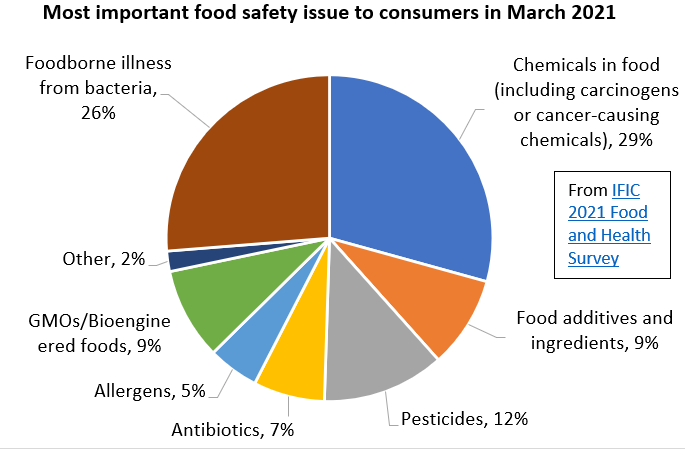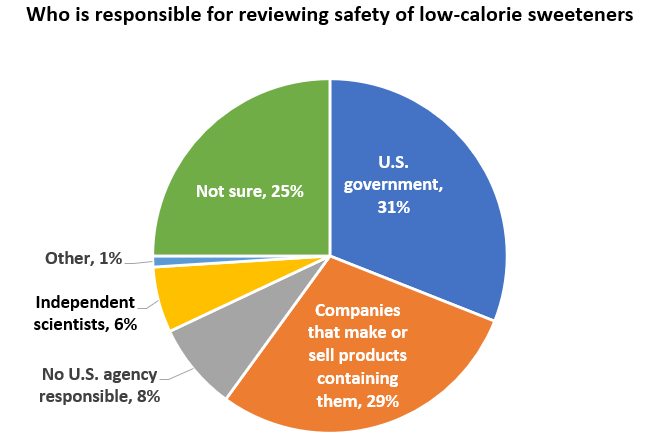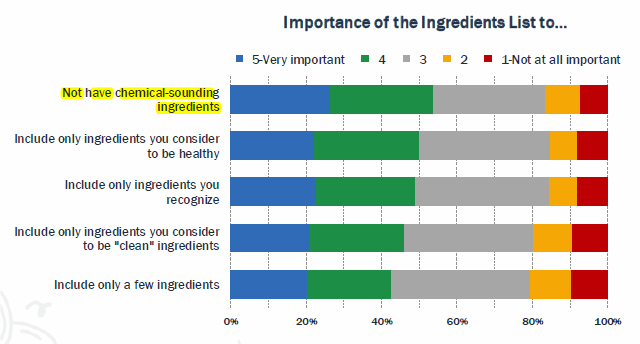Chemicals in food continue to be a top food safety concern among consumers
Tom Neltner, Chemicals Policy Director and Maricel Maffini, consultant
The latest annual food industry survey demonstrates that U.S. consumers continue to have significant concerns about chemicals in food. Specifically, the survey from the International Food Information Council (IFIC) found:
- 29% of consumers rated chemicals in food as their top food safety concern, more than any other issue, including foodborne illness from bacteria. Everyone rated chemicals in food among the top three concerns. Chemicals in food has been the top concern every year since 2017, tying risk from COVID-19 from food last year. It has been a significant concern back to the first IFIC Food and Health Survey in 2009.
- 69% of consumers did not realize that the U.S. government is responsible for reviewing the safety of low-calorie sweeteners, which are among the most well-known food additives.
- 54% of consumers reported it is important that ingredients do not have “chemical-sounding names” including 26% that rate it “very important.” Their opinion is primarily based on food safety and healthfulness concerns.
Our takeaway is that consumers continue to be concerned about chemicals in food, partly because they are not confident that the federal government is actually ensuring additives are safe. Therefore, they do their best to try and protect their health and safety by avoiding ingredients that sound like chemicals – the only way they see to control the perceived risk. In reaction to consumer concerns, food companies have undertaken “clean label” programs that either remove these ingredients (which can be helpful) or use names that do not sound like chemicals (which obscure the fact and can be misleading).
A better approach is to actually ensure the chemicals in food are safe and healthy rather than leaving consumers to judge products based on the sound of the ingredient names. Actual safety is the outcome that Congress intended when it adopted the Food Additives Amendment of 1958. Instead, the Food and Drug Administration (FDA), the agency with both the responsibility and the authority for food safety, allows companies to decide in secret that additives are safe, fails to consider the cumulative health effect of chemicals in the diet, and lacks any systematic reassessment of past decisions even when new evidence shows potential harm.
FDA needs to step up and address these shortcomings to make our food safe and restore consumer confidence. This involves not only improving its approach to addressing ingredient safety but also their approach towards contaminants that enter our food from the environment, from the packaging, or from food processing.
Chemicals in food is #1 food safety concern
According to the survey, conducted at the end of March 2021, just one in six surveyed is very confident that the food supply is safe. About half of consumers are only “somewhat confident” that food is safe, and one quarter say that they are either “not at all confident” or “not too confident.”
When consumers were asked to identify their most important food safety concern, 29% selected either “chemicals in food” or “carcinogens or cancer-causing chemicals in food”[1] as their #1 concern compared to 26% for “foodborne illness from bacteria.” Adding consumers who treated “pesticides” and “food additives and ingredients” as chemicals to the total means half of consumers rate chemicals as their top concern. See the figure below for more detail.
Chemicals in food has been top concern since 2017
Consumer concern with chemicals in food is not new. From 2017 to 2019[2], between 33%-35% of consumers rated chemicals in food as their top food safety concern, more than anything else. It dropped to 24% last year when IFIC surveyed consumers in April – as the pandemic dominated the news – and added the option of “food handling/food preparation related to the risk of COVID-19 from food”. Even then the pandemic tied for #1 with chemicals in food. IFIC did not offer COVID-19 as an option in 2021.
Most consumers don’t know the U.S. government is responsible for the safety of additives
Over the years, low/no-calorie sweeteners have been among the most widely recognized and controversial additives. For more than five years, IFIC has been surveying consumer sentiment on these additives. Those surveys consistently find that most consumers recognize that they need to reduce the amount of sugar they eat or drink with one-third likely to use low/no-calorie sweeteners as a viable alternative. Among those using low/no-calorie sweeteners, about a third see them as unhealthy or not good for you but apparently better than added sugar.
In its 2021 survey, IFIC apparently sought to better understand why consumers were so hesitant to accept that low/no calorie sweeteners are safe. It asked consumers who they thought was responsible for reviewing the safety of these chemicals. Presumably, if consumers thought that food manufacturers were responsible for the review and not the federal government, they would recognize the companies’ bias and be more hesitant. However, 29% of the surveyed thought companies are responsible for safety of their products. See figure below for their responses.
Only 31% of consumers thought the U.S. government is responsible for reviewing the safety of these additives and 8% thought no U.S. agency is responsible. Consumer perception is not particularly surprising and may be grounded on a general concern that the U.S. government is not watching out for their best interests, including chemicals added to food. Sweeteners like aspartame, sucralose, acesulfame-K, saccharin, and various sugar alcohols were approved by the Food and Drug Administration (FDA) as food additives until the late 1990s. Then, FDA began to turn over responsibility for additive safety to companies under a flawed interpretation of an exemption in the law for the use of substances that are Generally Recognized as Safe (GRAS). FDA allows companies to self-certify chemicals as safe without notice to the agency or the public with the option of seeking voluntary review. FDA posts the results of the voluntary reviews online and some companies have submitted notices for low/no-calorie sweeteners. Unfortunately, the agency depends on the companies to provide the notice and does not know how many substances are used without its knowledge.
Most consumers avoid chemical-sounding ingredients
The IFIC survey also explored the implications of consumer’s concern about chemicals in food. It found that 54% say it is “important” that ingredients do not have “chemical-sounding names” including 26% that rate it “very important.” That is more than any other concern about ingredients. The figure below provides details on the options and scoring.[3]
From our perspective, consumers should not feel the need to avoid chemical-sounding ingredients. Rather, they should have confidence that the food is safe from ingredients and contaminants that may harm them. Based on the IFIC survey, that is not the current situation.
FDA needs to step up to ensure the safety of our food
FDA and the food manufacturers are responsible for ensuring food chemicals are safe. Their failure leaves consumers struggling to fill the gap. With the exception of eight major allergens, consumers cannot realistically evaluate the safety of ingredients, or even know all of the ingredients that have been added, based on a product’s label.
While FDA is required by law to ensure substances added to our food are safe, the agency has not been doing its job. FDA needs to step up to ensure our food is safe by ending secrecy, using modern science, and reassessing the safety of chemicals approved decades ago. By taking this action, consumers will be less concerned about chemicals in general and may be less hesitant about buying foods with chemical-sounding ingredients or low/no calorie sweeteners.
[1] IFIC reports these options separately, but both explicitly refer to chemicals in food, we think it is more appropriate to combine them.
[2] Before 2017, IFIC adjusted the categories and their descriptions.
[3] This figure is reproduced from the 2021 IFIC report. The authors added the highlight.












